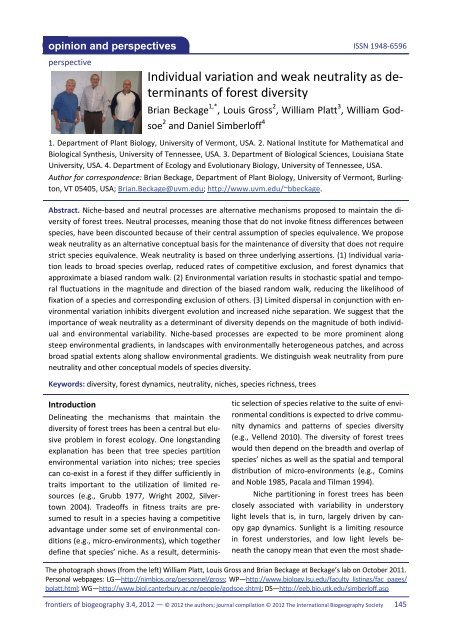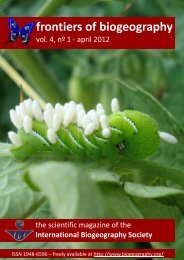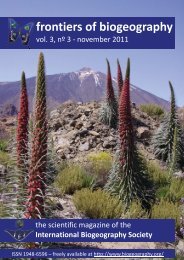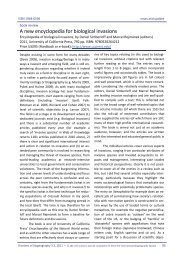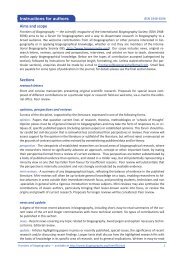Individual variation and weak neutrality as de - The International ...
Individual variation and weak neutrality as de - The International ...
Individual variation and weak neutrality as de - The International ...
Create successful ePaper yourself
Turn your PDF publications into a flip-book with our unique Google optimized e-Paper software.
opinion <strong>and</strong> perspectives<br />
ISSN 1948‐6596<br />
tic selection of species relative to the suite of environmental<br />
conditions is expected to drive community<br />
dynamics <strong>and</strong> patterns of species diversity<br />
(e.g., Vellend 2010). <strong>The</strong> diversity of forest trees<br />
would then <strong>de</strong>pend on the breadth <strong>and</strong> overlap of<br />
species’ niches <strong>as</strong> well <strong>as</strong> the spatial <strong>and</strong> temporal<br />
distribution of micro‐environments (e.g., Comins<br />
<strong>and</strong> Noble 1985, Pacala <strong>and</strong> Tilman 1994).<br />
Niche partitioning in forest trees h<strong>as</strong> been<br />
closely <strong>as</strong>sociated with variability in un<strong>de</strong>rstory<br />
light levels that is, in turn, largely driven by canopy<br />
gap dynamics. Sunlight is a limiting resource<br />
in forest un<strong>de</strong>rstories, <strong>and</strong> low light levels beneath<br />
the canopy mean that even the most sha<strong>de</strong>perspective<br />
<strong>Individual</strong> <strong>variation</strong> <strong>and</strong> <strong>weak</strong> <strong>neutrality</strong> <strong>as</strong> <strong>de</strong>terminants<br />
of forest diversity<br />
Brian Beckage 1,* , Louis Gross 2 , William Platt 3 , William Godsoe<br />
2 <strong>and</strong> Daniel Simberloff 4<br />
1. Department of Plant Biology, University of Vermont, USA. 2. National Institute for Mathematical <strong>and</strong><br />
Biological Synthesis, University of Tennessee, USA. 3. Department of Biological Sciences, Louisiana State<br />
University, USA. 4. Department of Ecology <strong>and</strong> Evolutionary Biology, University of Tennessee, USA.<br />
Author for correspon<strong>de</strong>nce: Brian Beckage, Department of Plant Biology, University of Vermont, Burlington,<br />
VT 05405, USA; Brian.Beckage@uvm.edu; http://www.uvm.edu/~bbeckage.<br />
Abstract. Niche‐b<strong>as</strong>ed <strong>and</strong> neutral processes are alternative mechanisms proposed to maintain the diversity<br />
of forest trees. Neutral processes, meaning those that do not invoke fitness differences between<br />
species, have been discounted because of their central <strong>as</strong>sumption of species equivalence. We propose<br />
<strong>weak</strong> <strong>neutrality</strong> <strong>as</strong> an alternative conceptual b<strong>as</strong>is for the maintenance of diversity that does not require<br />
strict species equivalence. Weak <strong>neutrality</strong> is b<strong>as</strong>ed on three un<strong>de</strong>rlying <strong>as</strong>sertions. (1) <strong>Individual</strong> <strong>variation</strong><br />
leads to broad species overlap, reduced rates of competitive exclusion, <strong>and</strong> forest dynamics that<br />
approximate a bi<strong>as</strong>ed r<strong>and</strong>om walk. (2) Environmental <strong>variation</strong> results in stoch<strong>as</strong>tic spatial <strong>and</strong> temporal<br />
fluctuations in the magnitu<strong>de</strong> <strong>and</strong> direction of the bi<strong>as</strong>ed r<strong>and</strong>om walk, reducing the likelihood of<br />
fixation of a species <strong>and</strong> corresponding exclusion of others. (3) Limited dispersal in conjunction with environmental<br />
<strong>variation</strong> inhibits divergent evolution <strong>and</strong> incre<strong>as</strong>ed niche separation. We suggest that the<br />
importance of <strong>weak</strong> <strong>neutrality</strong> <strong>as</strong> a <strong>de</strong>terminant of diversity <strong>de</strong>pends on the magnitu<strong>de</strong> of both individual<br />
<strong>and</strong> environmental variability. Niche‐b<strong>as</strong>ed processes are expected to be more prominent along<br />
steep environmental gradients, in l<strong>and</strong>scapes with environmentally heterogeneous patches, <strong>and</strong> across<br />
broad spatial extents along shallow environmental gradients. We distinguish <strong>weak</strong> <strong>neutrality</strong> from pure<br />
<strong>neutrality</strong> <strong>and</strong> other conceptual mo<strong>de</strong>ls of species diversity.<br />
Keywords: diversity, forest dynamics, <strong>neutrality</strong>, niches, species richness, trees<br />
Introduction<br />
Delineating the mechanisms that maintain the<br />
diversity of forest trees h<strong>as</strong> been a central but elusive<br />
problem in forest ecology. One longst<strong>and</strong>ing<br />
explanation h<strong>as</strong> been that tree species partition<br />
environmental <strong>variation</strong> into niches; tree species<br />
can co‐exist in a forest if they differ sufficiently in<br />
traits important to the utilization of limited resources<br />
(e.g., Grubb 1977, Wright 2002, Silvertown<br />
2004). Tra<strong>de</strong>offs in fitness traits are presumed<br />
to result in a species having a competitive<br />
advantage un<strong>de</strong>r some set of environmental conditions<br />
(e.g., micro‐environments), which together<br />
<strong>de</strong>fine that species’ niche. As a result, <strong>de</strong>terminis‐<br />
<strong>The</strong> photograph shows (from the left) William Platt, Louis Gross <strong>and</strong> Brian Beckage at Beckage’s lab on October 2011.<br />
Personal webpages: LG—http://nimbios.org/personnel/gross; WP—http://www.biology.lsu.edu/faculty_listings/fac_pages/<br />
bplatt.html; WG—http://www.biol.canterbury.ac.nz/people/godsoe.shtml; DS—http://eeb.bio.utk.edu/simberloff.<strong>as</strong>p<br />
frontiers of biogeography 3.4, 2012 — © 2012 the authors; journal compilation © 2012 <strong>The</strong> <strong>International</strong> Biogeography Society<br />
145
<strong>weak</strong> <strong>neutrality</strong><br />
tolerant forest trees require incre<strong>as</strong>ed light to<br />
reach the forest canopy (Canham 1989, Poulson<br />
<strong>and</strong> Platt 1996). When overstory trees are damaged<br />
or die, openings are created in the forest<br />
canopy; these canopy gaps are <strong>as</strong>sociated with<br />
elevated <strong>and</strong> spatially variable un<strong>de</strong>rstory light<br />
levels (Runkle 1981, Poulson <strong>and</strong> Platt 1989, Canham<br />
et al. 1990). Propagules or advance recruits<br />
of trees colonize are<strong>as</strong> before <strong>and</strong> after canopy<br />
gap formation (e.g., Schupp et al., 1989). Seedlings<br />
<strong>and</strong> juveniles subsequently compete, often<br />
intensely, for vertical position to capture sunlight<br />
<strong>and</strong> to ultimately gain direct access to sunlight<br />
through entry into the forest canopy (e.g., Peet<br />
<strong>and</strong> Christensen 1987, Schupp et al. 1989, Purves<br />
<strong>and</strong> Pacala 2008; but see Paine et al. 2008 for evi<strong>de</strong>nce<br />
that this competition may sometimes be<br />
<strong>weak</strong>). Competition among forest tree recruits for<br />
access to light <strong>and</strong> canopy gaps is pre‐emptive:<br />
seedlings established earlier in prior disturbances<br />
or in different types of subcanopy gaps (Connell et<br />
al. 1997) tend to have a competitive advantage<br />
over later arriving individuals because of their<br />
greater initial height <strong>and</strong> subsequent shading of<br />
competitors (Schwinning <strong>and</strong> Weiner 1998, Kwit<br />
<strong>and</strong> Platt 2003). Trees have unrestricted access to<br />
sunlight once they enter the canopy, <strong>and</strong> subsequently<br />
interact <strong>weak</strong>ly with other canopy trees,<br />
even for below‐ground resources (e.g., Wilson<br />
1993), while strongly suppressing recruits of both<br />
the same <strong>and</strong> different species through shading<br />
<strong>The</strong> gap dynamic paradigm is generalizable to<br />
many plant communities <strong>and</strong> h<strong>as</strong> broad application<br />
to closed‐canopy forests worldwi<strong>de</strong> (e.g.,<br />
Platt <strong>and</strong> Strong 1989).<br />
Broad empirical support for niche partitioning<br />
among forest trees h<strong>as</strong> been lacking <strong>de</strong>spite<br />
the importance of the gap‐dynamic paradigm. <strong>The</strong><br />
lack of support occurs even though there are<br />
known differences among tree species in use of<br />
light <strong>and</strong> other resources <strong>as</strong> well <strong>as</strong> in life history<br />
traits (e.g., Batista <strong>and</strong> Platt 2003, Beckage <strong>and</strong><br />
Clark 2003, Condit et al. 2006, Ibanez et al. 2009).<br />
Instead, extensive empirical studies of forest dynamics<br />
have found strong evi<strong>de</strong>nce of large individual<br />
variability <strong>and</strong> broad species overlap in performance<br />
(e.g., Clark et al. 2004). Overlap among<br />
species in fitness traits ultimately results from<br />
<strong>de</strong>mographic constraints <strong>and</strong> equalizing tra<strong>de</strong>offs<br />
that characterize individual trees. <strong>Individual</strong>s must<br />
allocate a finite pool of fixed carbon, <strong>and</strong> more<br />
allocation to one fitness trait necessarily means<br />
less to another trait, e.g., those that enhance colonization<br />
versus competitive ability (Tilman 1988,<br />
Wright 2002). Resulting allocation patterns vary<br />
among individuals within species <strong>as</strong> well <strong>as</strong> across<br />
species <strong>and</strong> lead to species overlap in fitness traits<br />
(Clark 2010). Broad overlap among forest tree<br />
species suggests that existing explanations of<br />
niche partitioning among species are ina<strong>de</strong>quate<br />
to explain the diversity of trees in forests.<br />
One alternative explanation is that high individual<br />
variability in performance is evi<strong>de</strong>nce that<br />
niche partitioning occurs largely among individuals<br />
rather than species (Clark 2010). If individuals<br />
within species exhibit consi<strong>de</strong>rable <strong>variation</strong> in<br />
fitness traits, then tra<strong>de</strong>offs manifested across<br />
individuals could provi<strong>de</strong> the b<strong>as</strong>is for niche partitioning<br />
of the environment. A niche would then be<br />
<strong>de</strong>fined by the region in multidimensional space<br />
occupied by individuals of a given species, <strong>and</strong> the<br />
resultant hyper‐dimensional niche would be difficult<br />
(or impossible) to me<strong>as</strong>ure fully (Clark et al.<br />
2007). Species would be separated in this hyperdimensional<br />
niche space, but would have apparently<br />
broad overlap when observing only a subset<br />
of that space (Fig. 1). This proposed explanation<br />
would reconcile empirical evi<strong>de</strong>nce of broad species<br />
overlap with niche partitioning, but is also<br />
'unfalsifiable' <strong>as</strong> any observed species overlap<br />
could be interpreted <strong>as</strong> implying that an unspecified<br />
dimension of niche space w<strong>as</strong> not me<strong>as</strong>ured.<br />
Weak <strong>neutrality</strong><br />
We propose another interpretation of broad species<br />
overlap <strong>as</strong> evi<strong>de</strong>nce of '<strong>weak</strong> <strong>neutrality</strong>'.<br />
Weak <strong>neutrality</strong> <strong>as</strong>serts that species dynamics are<br />
characterized by a bi<strong>as</strong>ed, stoch<strong>as</strong>tic walk towards<br />
fixation (Beckage et al. 2010). Broad species overlap<br />
implies that the species i<strong>de</strong>ntity of the individual<br />
that captures a given canopy gap is largely unpredictable<br />
<strong>and</strong> that the role of <strong>de</strong>terministic species<br />
selection is therefore relatively <strong>weak</strong> (Fig. 2)<br />
(Vellend 2010). Species overlap is not expected to<br />
146 © 2012 the authors; journal compilation © 2012 <strong>The</strong> <strong>International</strong> Biogeography Society — frontiers of biogeography 3.4, 2012
Brian Beckage et al.<br />
Figure 1. Separation of species in a hyper<br />
‐dimensional space can lead to apparent<br />
species overlap in lower‐dimensional<br />
space. Two hypothetical species (blue<br />
solid line <strong>and</strong> magenta broken line) are<br />
separated in two‐dimensional niche<br />
space but appear to overlap in a single<br />
dimensional that marginalizes over the<br />
second dimension.<br />
Figure 2. <strong>Individual</strong> <strong>variation</strong> in <strong>de</strong>mographic traits influences the probability that a given species captures a site un<strong>de</strong>r<br />
a given set of environmental conditions. A) Hypothetical fitness responses of two species (blue <strong>and</strong> magenta)<br />
with respect to an environmental gradient. B)‐D) represent the distribution of fitness responses of individuals of each<br />
species in environments i‐iii in panel A. Each species dominates the other species at either end of the environmental<br />
gradient, but large individual <strong>variation</strong> results in broad overlap un<strong>de</strong>r intervening environmental conditions. <strong>The</strong> arrow<br />
in panel B represents the range of individual <strong>variation</strong> for the magenta species un<strong>de</strong>r environment i, while the<br />
arrow in panel D represents the difference in fitness response (or bi<strong>as</strong>) between the two species distributions.<br />
frontiers of biogeography 3.4, 2012 — © 2012 the authors; journal compilation © 2012 <strong>The</strong> <strong>International</strong> Biogeography Society<br />
147
<strong>weak</strong> <strong>neutrality</strong><br />
be exact, however, <strong>as</strong> species are not precisely<br />
equivalent <strong>and</strong> the mean difference between pairs<br />
of species is the bi<strong>as</strong> favoring one species over<br />
another in a given environment. <strong>The</strong> bi<strong>as</strong> represents<br />
the <strong>de</strong>gree of niche separation (i.e., difference<br />
in selection probability) between species<br />
un<strong>de</strong>r a given set of environmental conditions.<br />
<strong>The</strong> resultant forest dynamics, reflecting both rele<strong>as</strong>e<br />
<strong>and</strong> capture of canopy space through mortality<br />
<strong>and</strong> recruitment, approximates a r<strong>and</strong>om<br />
walk (i.e., drift) with both <strong>de</strong>terministic <strong>and</strong> stoch<strong>as</strong>tic<br />
components (Beckage et al. 2010). Species<br />
overlap represents the stoch<strong>as</strong>tic component of<br />
the r<strong>and</strong>om walk, while the bi<strong>as</strong> represents the<br />
<strong>de</strong>terministic (niche partitioning) component (Fig.<br />
2). <strong>The</strong> rate of competitive exclusion is reduced <strong>as</strong><br />
the bi<strong>as</strong> <strong>de</strong>cre<strong>as</strong>es or <strong>as</strong> the species overlap incre<strong>as</strong>es,<br />
approaching the process of ecological<br />
drift (e.g., Ågren <strong>and</strong> Fagerström 1984, Brokaw<br />
<strong>and</strong> Busing 2000, Vellend 2010). If the bi<strong>as</strong> is small<br />
relative to individual variability, then species coexistence<br />
can result over ecological time scales, because<br />
a reduced rate of competitive exclusion<br />
means that long time periods are required for<br />
<strong>weak</strong>er competitors to be driven to local extinction.<br />
We additionally <strong>as</strong>sert that the magnitu<strong>de</strong><br />
<strong>and</strong> direction of the bi<strong>as</strong> fluctuates in space <strong>and</strong><br />
time in response to environmental <strong>variation</strong>, so<br />
that the bi<strong>as</strong> itself is stoch<strong>as</strong>tic <strong>and</strong>, thus, the r<strong>and</strong>om<br />
walk is unlikely to reach fixation on ecological<br />
time scales. Community dynamics can thus be<br />
approximately ('<strong>weak</strong>ly') neutral without requiring<br />
strict species equivalence. This broad overlap can<br />
also be consistent with mean species differences,<br />
i.e., differences that can be statistically significant<br />
but still characterized by broad overlap. Species<br />
richness <strong>and</strong> diversity of the forest community is<br />
then an emergent property that results from the<br />
sum of the separate competitions for canopy<br />
gaps, which is in contr<strong>as</strong>t to the <strong>de</strong>terministic<br />
community structure implied by niche partitioning.<br />
We <strong>de</strong>lineate two main sources of individual<br />
<strong>variation</strong> that contribute to species overlap in<br />
fitness attributes (Fig. 3). One is genotypic <strong>variation</strong><br />
that results from alteration of haploid <strong>and</strong><br />
diploid generations, <strong>and</strong> which inclu<strong>de</strong>s the r<strong>and</strong>om<br />
segregation <strong>and</strong> <strong>as</strong>sortment of genes in gametes<br />
<strong>and</strong> their subsequent recombination. <strong>The</strong><br />
unpredictability of pollen transport by wind or<br />
animal vectors can also contribute to the genotypic<br />
<strong>variation</strong> of the subsequent generation of<br />
individuals. <strong>The</strong> second source of individual <strong>variation</strong><br />
(i.e., phenotypic <strong>variation</strong>) results from <strong>variation</strong><br />
in the local environmental conditions experienced<br />
by individuals. Environmental <strong>variation</strong> is<br />
expressed through a reaction norm influencing<br />
phenotypic expression of a given genotype (e.g.,<br />
phenotypic pl<strong>as</strong>ticity) <strong>as</strong> well <strong>as</strong> through the differential<br />
fitness of individual genotypes in a given<br />
micro‐environment. <strong>The</strong>se sources of <strong>variation</strong><br />
together result in observed intr<strong>as</strong>pecific <strong>variation</strong><br />
that h<strong>as</strong> both a genetic <strong>and</strong> environmental component.<br />
We contend that large individual variability<br />
in fitness traits within species <strong>and</strong> resultant broad<br />
species overlap can be maintained by the coinci<strong>de</strong>nce<br />
of environmental <strong>variation</strong> <strong>and</strong> dispersal<br />
limitation. Divergent evolution could lead to reduced<br />
niche overlap, with species residing in<br />
unique regions of tra<strong>de</strong>‐off space, such that each<br />
species is the best competitor un<strong>de</strong>r some set of<br />
environmental conditions (i.e., its niche; Levins<br />
1968). Divergent evolution that incre<strong>as</strong>es niche<br />
separation of species can, however, be inhibited<br />
by unpredictable environmental <strong>variation</strong> in space<br />
<strong>and</strong> time in conjunction with inherent limitations<br />
on seed production <strong>and</strong> the stoch<strong>as</strong>ticity of seed<br />
dispersal (Hubbell <strong>and</strong> Foster 1986, Eldredge et al.<br />
2005). <strong>The</strong> spatial distribution of microenvironmental<br />
conditions (e.g., niche space)<br />
across a community is likely to vary at short spatial<br />
<strong>and</strong> temporal scales (i.e., environmental grain;<br />
Levins 1968), resulting in a rough fitness l<strong>and</strong>scape.<br />
<strong>The</strong> fitness of a given genotype would correspondingly<br />
be characterized by peaks <strong>and</strong> valleys<br />
on fine spatial scales. <strong>The</strong> fitness of an individual<br />
in this l<strong>and</strong>scape would thus be likely to<br />
shift rapidly in time in response to environmental<br />
<strong>variation</strong>. For instance, interactions between<br />
moisture availability (e.g., variability in precipitation<br />
events), temperature (e.g., p<strong>as</strong>sage of warm<br />
or cold fronts), <strong>and</strong> magnitu<strong>de</strong> of direct vs. indirect<br />
exposure to sunlight (e.g., clear or cloudy day,<br />
148 © 2012 the authors; journal compilation © 2012 <strong>The</strong> <strong>International</strong> Biogeography Society — frontiers of biogeography 3.4, 2012
Brian Beckage et al.<br />
sunflecks) <strong>as</strong> well <strong>as</strong> interactions with other species<br />
(e.g., seed predators, herbivores, pathogens,<br />
other plants, etc.) could result in fine scale temporal<br />
<strong>variation</strong> in fitness. Thus, the l<strong>and</strong>scape is rugged<br />
across space <strong>and</strong> 'dancing' in time with respect<br />
to both the fitness of a given genotype <strong>and</strong><br />
the dynamics of species. <strong>The</strong> pre‐emptive nature<br />
of competition among forest trees together with<br />
the unpredictable nature of the 'fitness terrain'<br />
that a dispersing individual is likely to experience<br />
limits the potential for species to specialize in narrowly<br />
<strong>de</strong>fined niches (or optimize traits, e.g.,<br />
Levins 1968, Brown <strong>and</strong> Pavlovic 1992, Clune et al.<br />
2008). <strong>The</strong> individual with the maximum fitness<br />
for a given environment is not likely to arrive at a<br />
location that maximizes its fitness, because arriving<br />
a fraction of a meter away or a day later can<br />
negate its fitness advantage (cf. elm‐oyster mo<strong>de</strong>l,<br />
Williams 1975). Species, in fact, often capture<br />
sites by <strong>de</strong>fault because of recruitment limitations<br />
(e.g., Hurtt <strong>and</strong> Pacala 1995). Species are generally<br />
not able to explore fully the spatial distribution of<br />
niches in a rugged, dancing l<strong>and</strong>scape. <strong>The</strong> optimum<br />
fitness l<strong>and</strong>scape in trait space, thus, is more<br />
Figure 3. <strong>Individual</strong> <strong>variation</strong> in fitness attributes results both from genotypic <strong>and</strong> environmental variability. A) Spatially<br />
continuous environmental <strong>variation</strong> is discretized at the scale of the individual such that one individual can occupy<br />
one square. <strong>The</strong> fitness response of an individual varies with genotype (B) <strong>and</strong> environment (C). Panel B shows<br />
the <strong>variation</strong> in fitness across genotypes in a given environment, while panel C shows <strong>variation</strong> in fitness across environments<br />
for a single genotype. <strong>The</strong>se two sources of <strong>variation</strong> in combination incre<strong>as</strong>e species’ variability in fitness<br />
responses (D).<br />
frontiers of biogeography 3.4, 2012 — © 2012 the authors; journal compilation © 2012 <strong>The</strong> <strong>International</strong> Biogeography Society<br />
149
<strong>weak</strong> <strong>neutrality</strong><br />
likely to be characterized by a broad plateau<br />
rather than a sharp peak.<br />
We predict that the relative importance of<br />
<strong>weak</strong> <strong>neutrality</strong> in structuring community dynamics<br />
will vary with the magnitu<strong>de</strong> of environmental<br />
<strong>and</strong> individual <strong>variation</strong>. Incre<strong>as</strong>ing environmental<br />
<strong>variation</strong> relative to individual <strong>variation</strong> will incre<strong>as</strong>e<br />
the bi<strong>as</strong> (i.e., <strong>de</strong>terministic species selection)<br />
of the r<strong>and</strong>om walk resulting in more rapid<br />
competitive exclusion. Thus, <strong>weak</strong> <strong>neutrality</strong> will<br />
be more important in relatively homogenous environments<br />
or across shallow environmental gradients<br />
(Fig. 4) because individual <strong>variation</strong> is more<br />
likely to exceed environmental <strong>variation</strong>. Niche<br />
differences can, however, be important even<br />
across shallow environmental gradients when<br />
consi<strong>de</strong>ring species from across a sufficiently<br />
broad spatial extent (Fig. 4), for example, from<br />
disparate locations along a latitudinal temperature<br />
gradient. Incre<strong>as</strong>ing environmental heterogeneity<br />
that is spatially structured <strong>and</strong> thus somewhat<br />
predictable at the scales of tree dispersal<br />
(e.g., in steep environmental gradients such <strong>as</strong> a<br />
mountain slope) will result in incre<strong>as</strong>ing importance<br />
of niche processes <strong>as</strong> environmental variability<br />
overwhelms individual variability. <strong>The</strong>re is<br />
greater support for niche partitioning in large canopy<br />
gaps, for instance, where environmental<br />
<strong>variation</strong> is relatively greater than in small canopy<br />
gaps (e.g., Poulson <strong>and</strong> Platt 1989; Whitmore<br />
1989), while studies in more homogenous environments<br />
offer little support for niche partitioning<br />
among trees (e.g., Gravel et al. 2008). Similarly,<br />
niche differences are expected to be incre<strong>as</strong>ingly<br />
important across broad geographic regions with<br />
corresponding larger environmental differences<br />
(Fig. 4). Temporal <strong>variation</strong> may operate in a similar<br />
manner to spatial heterogeneity, changing the<br />
magnitu<strong>de</strong> <strong>and</strong> direction of the bi<strong>as</strong> of the r<strong>and</strong>om<br />
walk to fixation (e.g., Beckage <strong>and</strong> Clark 2005),<br />
although perhaps with less capacity to influence<br />
species coexistence than purely spatial <strong>variation</strong><br />
(Sny<strong>de</strong>r 2008).<br />
<strong>The</strong> importance of neutral processes in<br />
structuring forest dynamics h<strong>as</strong> been largely discounted<br />
in ecology. Clark (2009), for example, argues<br />
that neutral mo<strong>de</strong>ls rely on stoch<strong>as</strong>ticity for<br />
coexistence, <strong>and</strong> that stoch<strong>as</strong>ticity is a reflection<br />
of a lack of information rather than a mechanism<br />
(Clark et al. 2007). This strictly <strong>de</strong>terministic view<br />
of ecological interactions, however, may be overly<br />
simplistic. If each species w<strong>as</strong> dispersed to all microsites,<br />
then the best adapted individual for a<br />
given niche might re<strong>as</strong>onably be expected to capture<br />
a particular niche throughout the l<strong>and</strong>scape,<br />
<strong>and</strong> a <strong>de</strong>terministic view of forest recruitment<br />
might be appropriate. But this is typically not the<br />
c<strong>as</strong>e because of dispersal limitations <strong>and</strong> environmental<br />
variability. While stoch<strong>as</strong>ticity is sometimes<br />
a proxy for uni<strong>de</strong>ntified <strong>de</strong>terministic (i.e.,<br />
niche) processes (Clark 2009), the inclusion of stoch<strong>as</strong>ticity<br />
to account for genetic <strong>variation</strong>, dispersal,<br />
<strong>and</strong> environmental <strong>variation</strong> represent unpredictability<br />
that is ‘real’ rather than simply st<strong>and</strong>ing<br />
in for uni<strong>de</strong>ntified <strong>de</strong>terminism in niche space.<br />
Purves <strong>and</strong> Turnbull (2010) maintain that it is exceedingly<br />
unlikely that species would display perfectly<br />
equalizing fitness tra<strong>de</strong>‐offs, <strong>and</strong> that pure<br />
<strong>neutrality</strong> is thus unlikely to be an important <strong>de</strong>terminant<br />
of species diversity in forests. Mo<strong>de</strong>l<br />
simulations do, in fact, show that even small <strong>de</strong>partures<br />
from strict <strong>neutrality</strong> in the absence of<br />
environmental heterogeneity result in dramatic<br />
<strong>de</strong>clines in species richness (Zhou <strong>and</strong> Zhang<br />
2008). In <strong>weak</strong> <strong>neutrality</strong>, we instead <strong>as</strong>sert that<br />
the magnitu<strong>de</strong> of <strong>de</strong>partures from strict <strong>neutrality</strong><br />
(fitness differences) are relatively small with respect<br />
to individual <strong>variation</strong>, <strong>and</strong> that their magnitu<strong>de</strong><br />
<strong>and</strong> direction stoch<strong>as</strong>tically vary across space<br />
<strong>and</strong> time. Species dynamics are then only approximately<br />
neutral on average over ecological time<br />
scales, <strong>and</strong> rapid fixation of any given species is<br />
prevented by species overlap together with the<br />
changing bi<strong>as</strong> of this r<strong>and</strong>om walk.<br />
<strong>The</strong> importance of intr<strong>as</strong>pecific individual<br />
<strong>variation</strong> in promoting species coexistence h<strong>as</strong><br />
been disputed. Lichstein et al. (2007) investigated<br />
the potential for individual <strong>variation</strong> to maintain<br />
species coexistence <strong>and</strong> found that the stabilizing<br />
effect of intr<strong>as</strong>pecific <strong>variation</strong> on species coexistence<br />
w<strong>as</strong> <strong>weak</strong>, because the species with the<br />
higher fitness will almost surely capture a given<br />
site <strong>as</strong> fecundity incre<strong>as</strong>es. In their simulations,<br />
species with small mean differences can still have<br />
150 © 2012 the authors; journal compilation © 2012 <strong>The</strong> <strong>International</strong> Biogeography Society — frontiers of biogeography 3.4, 2012
Brian Beckage et al.<br />
Figure 4. <strong>Individual</strong> <strong>variation</strong> in fitness attributes that is relatively large with respect to environmental heterogeneity<br />
can result in broad species overlap <strong>and</strong> approximately neutral dynamics. <strong>The</strong> magnitu<strong>de</strong> of individual <strong>and</strong> environmental<br />
<strong>variation</strong> influences the relative importance of <strong>weak</strong> <strong>neutrality</strong>. More homogenous environments (A) facilitate<br />
broad species overlap (B) <strong>and</strong> dynamics that are <strong>weak</strong>ly neutral. Incre<strong>as</strong>ing environmental heterogeneity (C)<br />
favors niche separation (D) but can still allow for <strong>weak</strong>ly neutral dynamics if individual <strong>variation</strong> is large <strong>and</strong> resultant<br />
species overlap is broad (E). Niche processes are thus likely to be more important in heterogeneous environments<br />
with spatial structure (F) at the scale of individuals, which incre<strong>as</strong>es the predictability of the environment with respect<br />
to species dispersal. We also expect the importance of neutral processes to vary at broa<strong>de</strong>r spatial scales <strong>as</strong>sociated<br />
with environmental gradients (G): Weak <strong>neutrality</strong> is expected to be more important in more homogenous<br />
are<strong>as</strong> (i) with relatively low environmental <strong>variation</strong> <strong>and</strong> less important in ecotonal are<strong>as</strong> or regions with steep environmental<br />
gradients (ii). H) Niche differences can be important even across shallow environmental gradients when<br />
consi<strong>de</strong>ring community differences across a sufficiently broad spatial extent (iii vs. iv). Note that we represent environmental<br />
<strong>variation</strong> spatially using colored squares discretized at the scale of the individual so that each cell can be<br />
occupied by a single individual. <strong>The</strong> x <strong>and</strong> y labels represent the spatial dimensions of the l<strong>and</strong>scape. We represent<br />
hypothetical species with different colors <strong>and</strong> line types, <strong>and</strong> environmental suitability for these species using similar<br />
sha<strong>de</strong>s of color, e.g., light <strong>and</strong> dark blue, in the l<strong>and</strong>scapes.<br />
frontiers of biogeography 3.4, 2012 — © 2012 the authors; journal compilation © 2012 <strong>The</strong> <strong>International</strong> Biogeography Society<br />
151
<strong>weak</strong> <strong>neutrality</strong><br />
very large differences in the tails of the distributions,<br />
<strong>and</strong> eventually some individual (seed) will<br />
be drawn from the tail of the distribution with a<br />
greater fitness than its competitor. One implication<br />
is that there is variance‐mean tra<strong>de</strong> off in fitness:<br />
at high levels of seed production, species<br />
with higher variance are favored, but at lower levels<br />
of seed production, species with a higher mean<br />
are favored (Lichstein et al. 2007). Thus, a competition‐colonization<br />
tra<strong>de</strong>‐off may also imply a corresponding<br />
tra<strong>de</strong>‐off in mean <strong>and</strong> variance of individual<br />
<strong>variation</strong> in fitness traits; 'colonizers' (with<br />
high fecundity) would benefit from high individual<br />
<strong>variation</strong> in fitness while 'competitors' (with low<br />
fecundity) would benefit from a high mean fitness.<br />
<strong>The</strong>ir study, however, did not consi<strong>de</strong>r tra<strong>de</strong>‐offs<br />
between competitive performance <strong>and</strong> fecundity,<br />
so that the optimum individual can almost surely<br />
disperse to each available site. Courbaud et al.<br />
(2010) begin to consi<strong>de</strong>r such tra<strong>de</strong>‐offs <strong>and</strong> show<br />
the potential for individual <strong>variation</strong> to have large<br />
effects on species coexistence <strong>and</strong> patterns of<br />
abundance. <strong>The</strong> implications of individual <strong>variation</strong><br />
have thus begun to be explored, but the<br />
<strong>de</strong>mographic processes consi<strong>de</strong>red have been<br />
limited <strong>and</strong> have not yet inclu<strong>de</strong>d consi<strong>de</strong>ration of<br />
broa<strong>de</strong>r <strong>and</strong> more mechanistic tra<strong>de</strong>‐offs, the<br />
heritability of individual <strong>variation</strong>, priority effects,<br />
the separation of genotypic <strong>variation</strong> from phenotypic<br />
pl<strong>as</strong>ticity <strong>and</strong> environmental <strong>variation</strong>, or<br />
more complex communities (e.g., those with more<br />
than two species).<br />
Weak <strong>neutrality</strong>, niches, <strong>and</strong> <strong>neutrality</strong><br />
We propose <strong>weak</strong> <strong>neutrality</strong> <strong>as</strong> an alternative<br />
mo<strong>de</strong>l of forest dynamics that contains <strong>as</strong>pects of<br />
both niche mo<strong>de</strong>ls <strong>and</strong> pure <strong>neutrality</strong>. We make<br />
three key <strong>as</strong>sertions in this conceptual mo<strong>de</strong>l of<br />
forest dynamics: 1) Intr<strong>as</strong>pecific (i.e., individual)<br />
<strong>variation</strong> in fitness traits results in broad species<br />
overlap with uncertain competitive outcomes,<br />
reduced rates of competitive exclusion, <strong>and</strong> forest<br />
dynamics that are characterized by a bi<strong>as</strong>ed r<strong>and</strong>om<br />
walk. <strong>The</strong> bi<strong>as</strong> of the r<strong>and</strong>om walk is the<br />
niche separation or mean fitness difference between<br />
species pairs. Both larger species differences<br />
<strong>and</strong> smaller intr<strong>as</strong>pecific <strong>variation</strong> result in<br />
incre<strong>as</strong>ing <strong>de</strong>partures from pure <strong>neutrality</strong>. 2) <strong>The</strong><br />
magnitu<strong>de</strong> <strong>and</strong> direction of the bi<strong>as</strong> of the r<strong>and</strong>om<br />
walk (i.e., how strongly a given species is favored)<br />
fluctuates in response to spatial <strong>and</strong> temporal environmental<br />
<strong>variation</strong>. <strong>The</strong> i<strong>de</strong>ntity of the species<br />
that is competitively favored, thus, varies both in<br />
space <strong>and</strong> time. This shifting bi<strong>as</strong> of the r<strong>and</strong>om<br />
walk reduces the likelihood of species fixation or<br />
competitive exclusion. 3) <strong>Individual</strong> <strong>variation</strong> <strong>and</strong><br />
species overlap are maintained by the unpredictability<br />
of fine scale environmental <strong>variation</strong> in<br />
conjunction with the stoch<strong>as</strong>tic nature of dispersal<br />
<strong>and</strong> inherent limits on fecundity. <strong>The</strong> optimal trait<br />
combination that maximizes fitness is likely to<br />
vary at fine spatial <strong>and</strong> temporal scales in response<br />
to changing micro‐environmental conditions,<br />
<strong>and</strong> individuals with such combinations of<br />
traits are unlikely to arrive at sites with exactly<br />
those conditions. <strong>The</strong> result of this imperfect mapping<br />
of fitness traits to niches is that the fitness<br />
l<strong>and</strong>scape is relatively broad <strong>and</strong> flat rather than<br />
narrow <strong>and</strong> sharply peaked, so that achieving<br />
equalizing fitness tra<strong>de</strong>offs may not be difficult (in<br />
contr<strong>as</strong>t to pure <strong>neutrality</strong>, e.g., Purves <strong>and</strong><br />
Turnbull 2010), <strong>and</strong> selective pressure to incre<strong>as</strong>e<br />
niche separation between species should be reduced.<br />
Our conceptualization of <strong>weak</strong> <strong>neutrality</strong><br />
differs from pure <strong>neutrality</strong> in two key ways. First,<br />
rather than specifying that species are exactly<br />
equivalent in per capita fitness (Hubbell 1979,<br />
Hubbell 2001), we instead specify that they have<br />
broad overlap <strong>and</strong> are only approximately neutral<br />
averaged across spatial <strong>and</strong> temporal environmental<br />
heterogeneity. Broad species overlap<br />
rather than per capita equivalence is the equalizing<br />
mechanism (Chesson 2000, Adler et al. 2007).<br />
This species overlap is similar to other mo<strong>de</strong>ls that<br />
consi<strong>de</strong>r niche overlap through <strong>de</strong>cre<strong>as</strong>ed fitness<br />
<strong>as</strong> species move away from their optimum environment<br />
(e.g., Gravel et al. 2006). We exp<strong>and</strong> on<br />
this by including two components in this overlap:<br />
individual <strong>variation</strong> in the optimum environment<br />
in niche space <strong>and</strong> <strong>de</strong>cre<strong>as</strong>es in fitness <strong>as</strong> individuals<br />
move away from their optimum environmental<br />
conditions. Second, in our formulation of <strong>weak</strong><br />
<strong>neutrality</strong>, fixation to a single species is inter‐<br />
152 © 2012 the authors; journal compilation © 2012 <strong>The</strong> <strong>International</strong> Biogeography Society — frontiers of biogeography 3.4, 2012
Brian Beckage et al.<br />
rupted by stoch<strong>as</strong>tic <strong>variation</strong> in the bi<strong>as</strong> of the<br />
r<strong>and</strong>om walk. <strong>The</strong> bi<strong>as</strong> of the r<strong>and</strong>om walk is not<br />
fixed <strong>and</strong> constant, but changes with environmental<br />
<strong>variation</strong> in space <strong>and</strong> time. In pure <strong>neutrality</strong>,<br />
in contr<strong>as</strong>t, speciation is the primary process<br />
that prevents fixation of the community to a<br />
single species.<br />
Weak <strong>neutrality</strong> provi<strong>de</strong>s a framework that<br />
can accommodate dynamics that range from<br />
niche‐driven to purely neutral <strong>de</strong>pending on the<br />
magnitu<strong>de</strong> of species differences, individual <strong>variation</strong>,<br />
<strong>and</strong> environmental <strong>variation</strong>. Species dynamics<br />
are expected to be predominately driven by<br />
<strong>weak</strong> <strong>neutrality</strong> when the ratio of intr<strong>as</strong>pecific to<br />
environmental variability is high <strong>and</strong> to be predominantly<br />
niche‐driven when this ratio is low.<br />
Environmental variability also contributes to intr<strong>as</strong>pecific<br />
<strong>variation</strong> through, for example, phenotypic<br />
pl<strong>as</strong>ticity, <strong>and</strong> thus we expect phenotypic<br />
pl<strong>as</strong>ticity to contribute to dynamics that are<br />
<strong>weak</strong>ly neutral. Species dynamics in ecological<br />
communities may be a mix of neutral <strong>and</strong> niche<br />
processes <strong>as</strong> the magnitu<strong>de</strong> of individual variability<br />
differs across species, the interspecific difference<br />
(i.e., bi<strong>as</strong>) varies between species pairs, <strong>and</strong><br />
environmental heterogeneity fluctuates spatially<br />
<strong>and</strong> temporally (Shmida <strong>and</strong> Wilson 1985, Gravel<br />
et al. 2006, Cadotte 2007). Nevertheless, <strong>weak</strong><br />
<strong>neutrality</strong> is likely to be an important <strong>and</strong> wi<strong>de</strong>spread<br />
process <strong>de</strong>termining forest dynamics <strong>and</strong><br />
the diversity of forest trees <strong>as</strong> well <strong>as</strong> for other<br />
plant <strong>and</strong> animal communities. We anticipate<br />
broad applicability of <strong>weak</strong> <strong>neutrality</strong> in community<br />
ecology.<br />
Distinguishing between niche <strong>and</strong> neutral<br />
processes using empirical species abundance distributions<br />
is problematic (e.g., Chisholm <strong>and</strong><br />
Pacala 2010), necessitating the need for alternative<br />
approaches to distinguish between mo<strong>de</strong>ls of<br />
diversity (e.g., Adler et al. 2007). We suggest that<br />
experimental studies that examine the validity of<br />
the <strong>as</strong>sertions un<strong>de</strong>rlying <strong>weak</strong> <strong>neutrality</strong> provi<strong>de</strong><br />
one means of examining <strong>weak</strong> <strong>neutrality</strong> <strong>as</strong> a <strong>de</strong>terminant<br />
of community dynamics. Experiments<br />
are difficult to conduct with long‐lived organisms<br />
like forest trees, but may be possible with, for example,<br />
annual plants or even with microorganisms<br />
with short generation times. Empirical studies<br />
that, for instance, investigate the relationship between<br />
the magnitu<strong>de</strong> of environmental <strong>and</strong> individual<br />
<strong>variation</strong> <strong>and</strong> species diversity can be used<br />
to examine <strong>weak</strong> <strong>neutrality</strong> in communities with<br />
long generation times such <strong>as</strong> forests. Furthermore,<br />
the <strong>de</strong>velopment of analytic or computational<br />
mo<strong>de</strong>ls that incorporate the components of<br />
<strong>weak</strong> <strong>neutrality</strong> can provi<strong>de</strong> for specific predictions<br />
of <strong>as</strong>sociated species <strong>and</strong> community dynamics<br />
<strong>and</strong> tests of <strong>weak</strong> <strong>neutrality</strong>.<br />
Acknowledgments<br />
<strong>The</strong> authors acknowledge Gabriela Bucini, James<br />
Rosin<strong>de</strong>ll <strong>and</strong> an anonymous reviewer for insightful<br />
comments that improved the manuscript.<br />
Brian Beckage is grateful for support from the National<br />
Science Foundation through award 0950347<br />
<strong>and</strong> sabbatical support from the University of Vermont<br />
<strong>and</strong> the National Institute for Mathematical<br />
<strong>and</strong> Biological Synthesis (NIMBioS). William Godsoe<br />
acknowledges the support of NIMBioS<br />
through a postdoctoral fellowship <strong>and</strong> Bill Platt<br />
acknowledges NIMBioS support <strong>as</strong> a short‐term<br />
visitor. NIMBioS is sponsored by the National Science<br />
Foundation, the U.S. Department of Homel<strong>and</strong><br />
Security, <strong>and</strong> the U.S. Department of Agriculture<br />
through NSF Award #EF‐0832858, with additional<br />
support from <strong>The</strong> University of Tennessee,<br />
Knoxville.<br />
References<br />
Adler, P.B., HilleRisLambers, J. & Levine, J.M. (2007) A<br />
niche for <strong>neutrality</strong>. Ecology Letters, 10, 95‐104.<br />
Ågren, G.I. & Fagerström, T. (1984) Limiting dissimilarity<br />
in plants: R<strong>and</strong>omness prevents exclusion of<br />
species with similar competitive abilities. Oikos,<br />
43, 369‐375.<br />
Batista, W.B. & Platt, W.J. (2003) Tree population response<br />
to hurricane disturbance: syndromes in a<br />
southe<strong>as</strong>tern United States old‐growth forest.<br />
Journal of Ecology, 91, 197‐212.<br />
Beckage, B, Godsoe, W., Gross, L., Platt, W.J. & Simberloff,<br />
D. (2010) <strong>Individual</strong> <strong>variation</strong> slows competitive<br />
exclusion. Science (E‐Letter), http://<br />
www.sciencemag.org/cgi/eletters/327/5969/1129.<br />
Beckage, B. & Clark, J.S. (2003) Seedling survival <strong>and</strong><br />
growth of three southern Appalachian forest<br />
tree species: the role of spatial heterogeneity.<br />
frontiers of biogeography 3.4, 2012 — © 2012 the authors; journal compilation © 2012 <strong>The</strong> <strong>International</strong> Biogeography Society<br />
153
<strong>weak</strong> <strong>neutrality</strong><br />
Ecology, 84, 1849‐1861.<br />
Beckage, B. & Clark, J.S. (2005) Does predation contribute<br />
to tree diversity Oecologia, 143, 458‐469.<br />
Brokaw N. & Busing, R.T. (2000) Niche versus chance<br />
<strong>and</strong> tree diversity in forest gaps. Trends in Ecology<br />
<strong>and</strong> Evolution, 15, 183–188.<br />
Brown, J.S. & Pavlovic, N.B. (1992) Evolution in heterogeneous<br />
environments: effects of migration on<br />
habitat specialization. Evolutionary Ecology, 6,<br />
360‐382.<br />
Cadotte, M.W. (2007) Concurrent niche <strong>and</strong> neutral<br />
processes in the competition‐colonization mo<strong>de</strong>l<br />
of species coexistence. Proceedings of the Royal<br />
Society B, 274, 2739‐2744.<br />
Canham, C.D. (1989) Different responses to gaps<br />
among sha<strong>de</strong>‐tolerant tree species. Ecology, 70,<br />
548‐550.<br />
Canham, C.D., Denslow, J.S., Platt, W.J, Runkle, J.R.,<br />
Spies, T.A. & White, P.S. (1990) Light regimes<br />
beneath closed canopies <strong>and</strong> tree‐fall gaps in<br />
temperate <strong>and</strong> tropical forests. Canadian Journal<br />
of Forest Research, 20, 620‐631.<br />
Chesson, P. (2000) Mechanisms of maintenance of species<br />
diversity. Annual Review of Ecology <strong>and</strong><br />
Systematics, 31, 343‐366.<br />
Chisholm, R.A. & Pacala, S.W. (2010) Niche <strong>and</strong> neutral<br />
mo<strong>de</strong>ls predict <strong>as</strong>ymptotically equivalent species<br />
abundance distributions in high‐diversity<br />
ecological communities. Proceedings of the National<br />
Aca<strong>de</strong>my of Sciences USA, 107, 15821‐<br />
15825.<br />
Clark, J.S. (2009) Beyond neutral science. Trends in<br />
Ecology <strong>and</strong> Evolution, 24, 8‐15.<br />
Clark, J.S. (2010) <strong>Individual</strong>s <strong>and</strong> the <strong>variation</strong> nee<strong>de</strong>d<br />
for high species diversity in forest trees. Science,<br />
327, 1129‐1132.<br />
Clark, J.S., Dietze, M., Chakraborty, S., Agarwal, P.K.,<br />
Ibanez, I., LaDeau, S. & Wolosin, M. (2007) Resolving<br />
the biodiversity paradox. Ecology Letters,<br />
10, 647‐659.<br />
Clark, J.S., LaDeau, S. & Ibanez, I. (2004) Fecundity of<br />
trees <strong>and</strong> the colonization‐competition hypothesis.<br />
Ecological Monographs, 74, 415‐442.<br />
Clune, J., Misevic, D., Ofria, C., Lenski, R.E., Elena, S.F. &<br />
Sanjuan, R. (2008) Natural selection fails to optimize<br />
mutation rates for long‐term adaptation on<br />
rugged fitness l<strong>and</strong>scapes. PLOS Computational<br />
Biology, 4, e1000187.<br />
Comins, H.N. & Noble, I.R. (1985) Dispersal, variability,<br />
<strong>and</strong> transient niches: species coexistence in a<br />
uniformly variable environment. American Naturalist,<br />
126, 706‐723.<br />
Condit, R., Ashton, P., Bunyavejchewin, S., et al. (2006)<br />
<strong>The</strong> importance of <strong>de</strong>mographic niches to tree<br />
diversity. Science, 313, 98‐101.<br />
Connell, J.H., Lowman, M.D. & Noble, I.R. (1997) Subcanopy<br />
gaps in temperate <strong>and</strong> tropical forests.<br />
Australian Journal of Ecology, 22, 163‐168.<br />
Courbaud, B., Vieille<strong>de</strong>nt, G. & Kunstler, G. (2010) Intra<br />
‐specific variability <strong>and</strong> the competition–<br />
colonisation tra<strong>de</strong>‐off: coexistence, abundance<br />
<strong>and</strong> stability patterns. <strong>The</strong>oretical Ecology, 1‐11.<br />
Eldredge, N., Thompson, J.N., Brakefield, P.M., et al.<br />
(2005) <strong>The</strong> dynamics of evolutionary st<strong>as</strong>is. Paleobiology,<br />
31, 133‐145.<br />
Gravel, D., Canham. C.D., Beau<strong>de</strong>t. M. & Messier, C.<br />
(2006) Reconciling niche <strong>and</strong> <strong>neutrality</strong>: the continuum<br />
hypothesis. Ecology Letters, 9, 399‐409.<br />
Gravel, D., Beau<strong>de</strong>t, M. & Messier, C. (2008) Partitioning<br />
the factors of spatial <strong>variation</strong> in regeneration<br />
<strong>de</strong>nsity of sha<strong>de</strong>‐tolerant tree species. Ecology,<br />
89, 2879‐2888.<br />
Grubb, P.J. (1977) <strong>The</strong> maintenance of species‐richness<br />
in plant communities: the importance of the<br />
regeneration niche. Biological Reviews, 52, 107‐<br />
145.<br />
Hubbell, S.P. (1979) Tree dispersion, abundance, <strong>and</strong><br />
diversity in a tropical dry forest. Science, 203,<br />
1299‐1309.<br />
Hubbell, S.P. & Foster, R.B. (1986) Biology, chance, <strong>and</strong><br />
history <strong>and</strong> the structure of tropical rain forest<br />
tree communities. In Community ecology (ed. by<br />
J. Diamond <strong>and</strong> T.J. C<strong>as</strong>e), pp. 314–329. Harper<br />
& Row, New York.<br />
Hubbell, S.P. (2001) <strong>The</strong> unified neutral theory of biodiversity<br />
<strong>and</strong> biogeography. Monographs in population<br />
biology. Princeton University Press,<br />
Princeton, NJ.<br />
Hurtt G. C. & Pacala, S.W. (1995) <strong>The</strong> consequences of<br />
recruitment limitation: reconciling chance, history,<br />
<strong>and</strong> competitive differences among plants.<br />
Journal of <strong>The</strong>oretical Biology, 176, 1‐12.<br />
Ibanez, I., Clark, J.S. & Dietze, M. (2009) Estimating performance<br />
of potential migrant species. Global<br />
Change Biology, 15, 1173‐1188.<br />
Kwit, C. & Platt, W.J. (2003) Disturbance history influences<br />
regeneration of non‐pioneer un<strong>de</strong>rstory<br />
trees. Ecology, 84, 2575‐2581.<br />
Levins, R. (1968) Evolution in changing environments.<br />
Princeton University Press, Princeton, NJ.<br />
Lichstein, J.W., Dushoff, J., Levin, S.A. & Pacala, S.W.<br />
(2007) Intr<strong>as</strong>pecific Variation <strong>and</strong> Species Coexistence.<br />
<strong>The</strong> American Naturalist, 170, 807‐818.<br />
Pacala, S.W. & Tilman, D. (1994) Limiting similarity in<br />
mechanistic <strong>and</strong> spatial mo<strong>de</strong>ls of plant competition<br />
in heterogeneous environments. <strong>The</strong><br />
American Naturalist, 143, 222‐257.<br />
Paine, C.E.T, Harms, K.E., Schnitzer, S.A. & Carson, W.P.<br />
(2008) Weak competition among tropical tree<br />
seedlings: Implications for species coexistence.<br />
Biotropica, 40, 432‐440.<br />
154 © 2012 the authors; journal compilation © 2012 <strong>The</strong> <strong>International</strong> Biogeography Society — frontiers of biogeography 3.4, 2012
Brian Beckage et al.<br />
Peet, R.K. & Christensen, N.L. (1987) Competition <strong>and</strong><br />
tree <strong>de</strong>ath. BioScience, 37, 586‐595.<br />
Platt, W.J. & Strong, D.R. (1989) Special feature: Gaps<br />
in forest ecology. Ecology, 70, 535‐535.<br />
Poulson, T.L. & Platt, W.J. (1989) Gap light regimes influence<br />
canopy tree diversity. Ecology, 70, 553‐<br />
555.<br />
Poulson, T.L. & Platt, W.J. (1996) Replacement patterns<br />
of beech <strong>and</strong> sugar maple in Warren Woods,<br />
Michigan. Ecology, 77, 1234‐1253.<br />
Purves, D. & Pacala, S. (2008) Predictive mo<strong>de</strong>ls of forest<br />
dynamics. Science, 320, 1452‐1453.<br />
Purves, D.W. & Turnbull, L.A. (2010) Different but<br />
equal: the implausible <strong>as</strong>sumption at the heart<br />
of neutral theory. Journal of Animal Ecology, 79,<br />
1215‐1225.<br />
Runkle, J.R. (1981) Gap regeneration in some oldgrowth<br />
forests of the e<strong>as</strong>tern United States.<br />
Ecology, 62, 1041‐1051.<br />
Schupp, E.W., Howe, H.F., Augspurger, C.K. & Levey,<br />
D.J. (1989) Arrival <strong>and</strong> survival in tropical treefall<br />
gaps. Ecology, 70, 562–564.<br />
Schwinning, S. & Weiner, J. (1998) Mechanisms <strong>de</strong>termining<br />
the <strong>de</strong>gree of size <strong>as</strong>ymmetry in competition<br />
among plants. Oecologia, 113, 447‐455.<br />
Shmida, A. & Wilson, M.V. (1985) Biological <strong>de</strong>terminants<br />
of species diversity. Journal of Biogeography,<br />
12, 1‐20.<br />
Silvertown, J. (2004) Plant coexistence <strong>and</strong> the niche.<br />
Trends in Ecology <strong>and</strong> Evolution, 19, 605‐611.<br />
Sny<strong>de</strong>r, R.E. (2008) When does environmental <strong>variation</strong><br />
most influence species coexistence <strong>The</strong>oretical<br />
Ecology, 1, 129‐139.<br />
Tilman, D. (1988) Plant strategies <strong>and</strong> the dynamics <strong>and</strong><br />
structure of plant communities. Princeton University<br />
Press, Princeton, NJ.<br />
Vellend, M. (2010) Conceptual synthesis in community<br />
ecology. <strong>The</strong> Quarterly Review of Biology, 85,<br />
183‐206.<br />
Whitmore, T.C. (1989) Canopy gaps <strong>and</strong> the two major<br />
groups of forest trees. Ecology, 70, 536–538.<br />
Williams, G.C. (1975) Sex <strong>and</strong> Evolution. Princeton University<br />
Press, Princeton, NJ.<br />
Wilson, S.D. (1993) Belowground competition in forest<br />
<strong>and</strong> prairie. Oikos, 68, 146‐150.<br />
Wright, J. (2002) Plant diversity in tropical forests: a<br />
review of mechanisms of species coexistence.<br />
Oecologia, 130, 1‐14.<br />
Zhou, S.‐R. & Zhang, D.‐Y. (2008). A nearly neutral<br />
mo<strong>de</strong>l of biodiversity. Ecology, 89, 248‐258.<br />
Edited by Thiago F. Rangel<br />
frontiers of biogeography 3.4, 2012 — © 2012 the authors; journal compilation © 2012 <strong>The</strong> <strong>International</strong> Biogeography Society<br />
155


